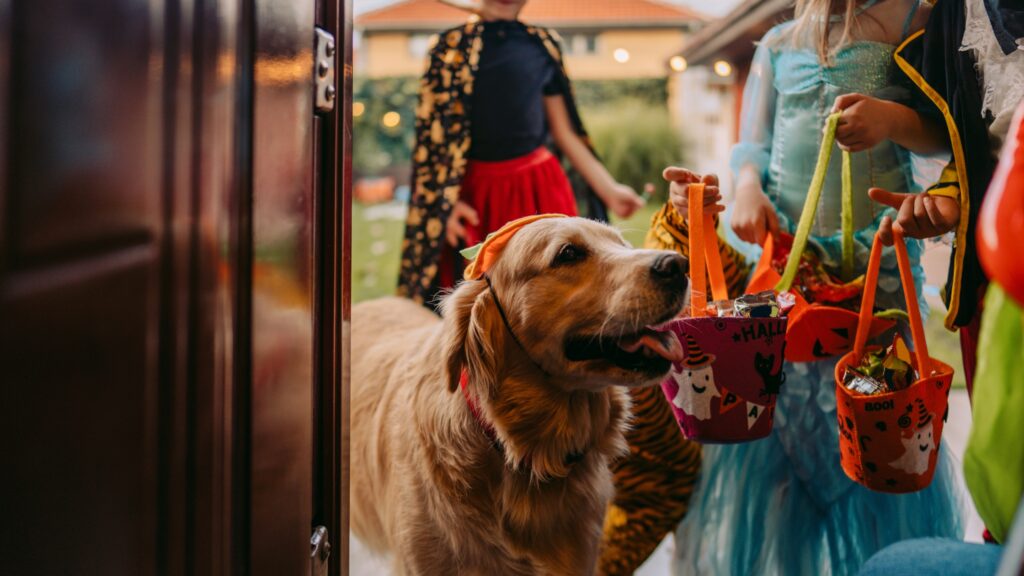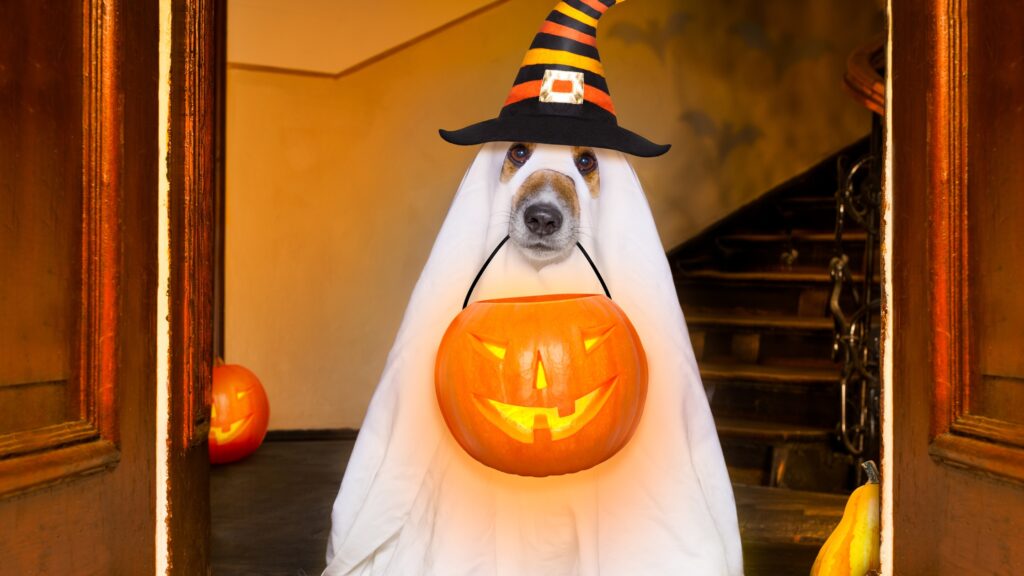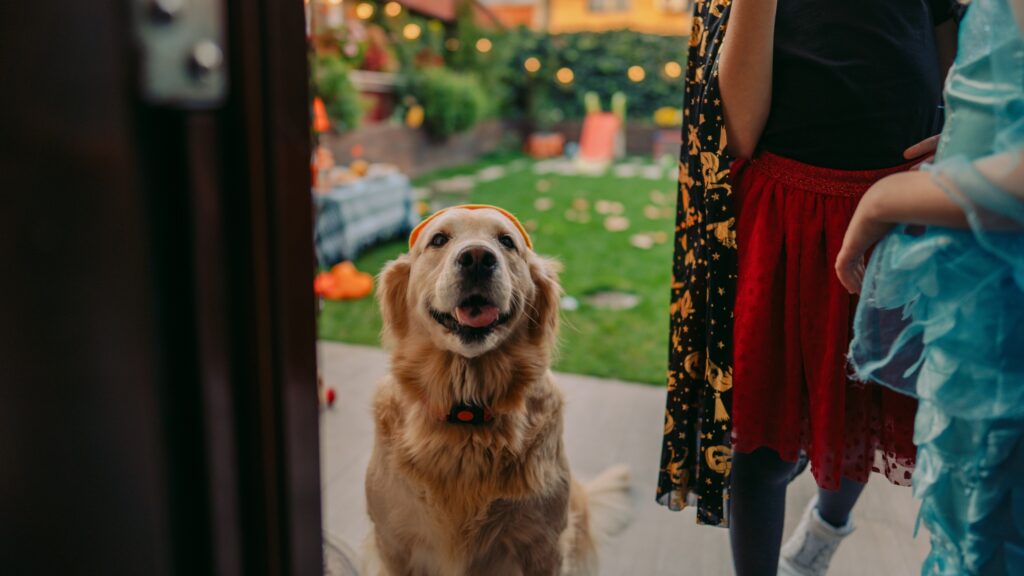October is here, and that means one thing—Halloween is just around the corner!
The days are getting cooler, and the nights are getting longer. Kids everywhere are gearing up to become little monsters, superheroes, and princesses, eager to fill their bags with candy and have some spooky fun.
But while Halloween is a blast for us humans, it can be a bit of a nightmare for our pets. Between the loud noises, dangerous foods, and all those tempting decorations, there are plenty of reasons to keep a close eye on your furry friends this Halloween.
To make sure everyone has a “fiendishly” good time, let’s dive into some tips on how to keep your pet safe on Halloween.
Candy Anyone?
First things first, let’s talk about the candy. I know it’s tempting to share your Halloween haul with your pet—after all, who can resist those puppy-dog eyes? But trust me, sweets and treats are for the kids, not your pets.
Chocolate, in particular, can be incredibly dangerous for dogs and cats. Chocolate contains theobromine, a stimulant that our pets simply can’t metabolize like we do. Even a small amount can lead to symptoms like vomiting, diarrhea, excessive thirst, and even more serious issues like seizures or, in extreme cases, death. Yikes, right?

And it’s not just chocolate you need to worry about. Many baked goods contain artificial sweeteners like xylitol, which is also toxic to pets. So, as much as your furry friend might beg for a taste, it’s best to keep the Halloween candy far out of their reach. Instead, stick to dog or cat treats that you know are safe and won’t upset their stomachs.
Halloween Decorations
Halloween decorations are another potential hazard for your pets.
Those glowing jack-o’-lanterns with flickering candles might look festive, but they’re also a fire hazard if your pet decides to investigate with a curious nose or swat with a paw. A tipped-over pumpkin could lead to burns or even start a fire, so it’s best to keep any open flames out of your pet’s reach. If you’re using electric or battery-operated lights, make sure the cords are safely tucked away to prevent chewing.
And let’s not forget about those spooky decorations hanging around your home. Some pets might find them irresistible chew toys, but swallowing bits of plastic or fabric can lead to digestive issues or worse. When setting up your Halloween decor, think about what might be within your pet’s reach and make sure it’s safe or secure.
Sneaky Petes
Is your pet an escape artist? Halloween might just be their big opportunity to make a break for it.
With trick-or-treaters coming and going all night, your front door will be opening and closing constantly, and the loud noises and strange costumes could easily spook your pet. If your pet has a tendency to dart out the door, keep a close eye on them and make sure they’re wearing identification tags just in case they manage to sneak out.
Even better, consider keeping them in a separate room away from the front door during peak trick-or-treating hours.
It’s also important to know your pet’s tolerance for strangers. Even the most sociable pets can get freaked out by people in masks and costumes.
If your pet seems stressed or agitated, it’s best to give them a quiet space where they can relax until the excitement dies down. After all, they don’t understand what Halloween is all about—those little ghouls and goblins knocking on your door are just a big, scary mystery to them!
Costume Mania

Ah, pet costumes—how could we not talk about them? According to the American Pet Products Association, pet owners spend over $200 million each season on holiday costumes for their pets. That’s a lot of little pumpkins and superheroes running around! But while costumes can be adorable, they’re not always a hit with our four-legged friends.
Before you dress up your pet, consider their comfort and safety.
Does the costume restrict their movement, vision, or breathing?
Does it have small parts that could be chewed off and swallowed?
If so, it might be better to skip the full outfit and opt for something simple, like a Halloween-themed bandana. And if you do go for a full costume, make sure to introduce it to your pet gradually and watch for any signs of discomfort. The last thing you want is for your pet to feel stressed or overheated because of their outfit.
Also, don’t forget to keep your pet’s collar and ID tags on, even if they’re in costume. If your pet gets spooked and makes a run for it, having updated contact information on their collar or microchip is the best way to ensure they get back home safely.
Trick or Treating

If your pet is coming along for trick-or-treating, there are a few extra precautions to keep in mind.
First, make sure an adult is holding the leash—kids are often too distracted by the excitement of the night to keep a firm grip, and the last thing you want is for your pet to slip away.
Stick to a traditional, non-retractable leash for better control, and keep your pet on the sidewalk while the kids go up to the door for their treats. This helps avoid any unexpected encounters with other pets who might live at the house you’re visiting.
Remember, not every dog or cat enjoys the chaos of trick-or-treating, so if your pet seems anxious or overwhelmed, it might be best to leave them at home in a quiet, comfortable spot.
Quick Tips
To wrap things up, here are some quick tips to help you keep your pet safe on Halloween:
- Confine your pet: If your pet isn’t used to kids or tends to bolt for the door, consider crating them or keeping them in a separate room during trick-or-treat time.
- Skip the doorbell: A constant ringing doorbell can be stressful. Put up a sign asking trick-or-treaters to knock instead, or better yet, greet them outside if the weather allows.
- Watch out for candles: Keep pets away from lit candles, especially in pumpkins, to prevent burns or fires.
- Be cautious with costumes: Make sure any costumes are safe, comfortable, and don’t restrict your pet’s movement or senses. Avoid using rubber bands to secure costumes, as they can dig into the skin and cause injuries.
- No candy for pets: Stick to pet-friendly treats to avoid any health issues from chocolate or artificial sweeteners.
- Keep ID tags on: Ensure your pet’s collar and tags stay on all night, and check that their microchip information is up to date.
Halloween is a fun and exciting time, but it’s important to be mindful of our pets’ safety.
With a little extra care and attention, you can make sure your furry friend has a happy, safe, and stress-free Halloween. So go ahead and enjoy the festivities—just don’t forget about your four-legged family members while you’re at it!